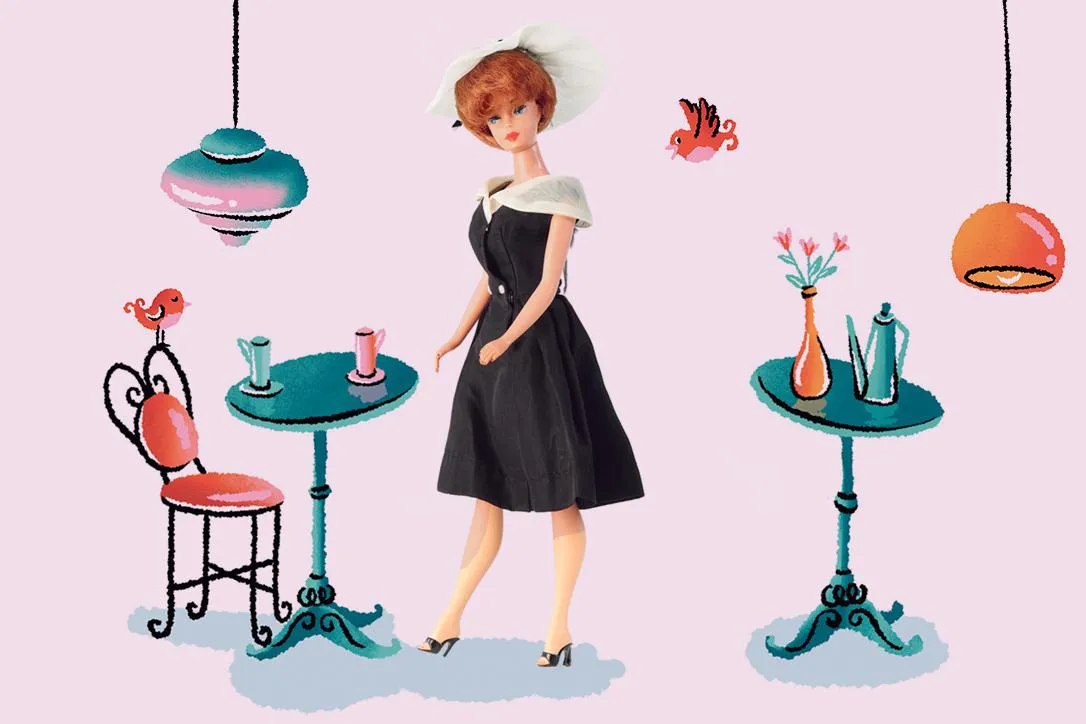
When I was still in single digits back in 1961, my best friend was named Barbara Millicent Roberts. You’re acquainted with her by her nickname: Barbie.
Mattel introduced Barbie, “the teenage fashion doll!” to the world on March 9, 1959. She came in two versions, blond and brunette. Created at one-sixth human scale, she stood 11.5 inches tall, making her about the height of a five-foot-eight woman. Her vinyl skin was a pinkish-beige hue the colour of unbleached silk. She cost three dollars, and her clothes and accessories were sold separately, priced from one dollar to five. That first year, Mattel brought out 22 outfits for their new doll.
The Barbie my parents bought me in 1961 came wearing the now-famous black-and-white-striped zebra bathing suit that showed off her buxom figure and wasp waist. Her painted nails matched her red lipstick, and her blue eyes glanced to the left, befitting the hauteur of the runway model she was designed to be. Her hair, which Mattel termed “titian,” was the colour of a bright new penny.
Before Barbie, most dolls were modelled on babies. But Barbie’s inventor, Ruth Handler, said she wanted Mattel to create a more adult doll onto which girls could project their own dreams.
That may have been Handler’s goal, but I was more interested in Barbie’s clothes than what she might do while wearing them. Her outfits were so glamorous! Each one looked like it could have been worn by Audrey Hepburn: her little black dress had a through-line straight to “Breakfast at Tiffany’s”; her chic trench belonged in “Charade.”
The clothes were also exquisitely tailored: fashioned from fine fabrics with finished seams and assembled with miniature snaps, zippers and tiny buttons to make them manageable for small fingers. Coats were lined with satin, evening dresses were visions in taffeta and tulle, ball gowns were resplendent in brocade. Until around 1967, Barbie and her clothes were machine-made in Japan and hand-finished by Japanese housewives who added the tiny adornments.
As much as I enjoyed dressing my Barbie in her store-bought outfits, I also had fun creating clothes for her myself. After plundering my mother’s storehouse of rickrack and ribbons, I used her pinking shears to cut material and became adept with glue, no sewing required. I even made a Barbie-sized bed for my doll by gluing pieces of balsa wood together, then crafting sheets, blankets and pillows from stray fabric. I also dipped into my mother’s huge collection of miniatures — furniture, kitchen implements, table settings — to construct dioramas where Barbie could show off her clothes.
In 1965, when my family moved from one leafy Toronto neighbourhood to another, I packed up my Barbie and her finery. She didn’t come out again to play until the early 1970s, when my older sister’s two daughters, Anne and Lise, hit their tweens.
By then I was at university, and my mother was the keeper of my doll and her various accoutrements. She invited Anne and Lise to play with my vintage Barbie within the confines of her living room coffee table, cautioning them to be “very careful” with her. Like me, Anne and Lise built houses, filling them with furniture they made. They created flowy ball gowns for Barbie out of Kleenex.
By the time Anne and Lise became teenagers, they had their own Barbies, as well as Ken dolls (something I never had) in both “regular and Malibu” versions, as well as the dolls PJ and Skipper. Times had changed since I was a kid. Their dolls had sex “a lot,” Lise remembers. “Barbie was always getting it on.”
When Anne and Lise were about 15, my vintage Barbie was retired once again. She didn’t reappear until my own daughter, Em, was in elementary school. For her, playing with Barbie was “all about the clothes, about making different outfits,” she says. We shared the fun of buying new clothes for her. We have happy memories of getting our feet wet on dewy July mornings at a farmers’ market in the Madawaska Valley, where a local woman sold crocheted garments tailored to fit our doll. Should we get the sheath in ivory or bubble-gum pink?
Em, now a graduate student living in another city, told me I’d find the old Barbies stored in plastic bins under her bed. I dug out the dolls and their clothes and spread them around her old room. On a recent visit home, she saw them and “fell under Barbie’s spell” for two hours, brushing the dolls’ hair and organizing their clothes.
“It was really meditative,” she said. “I couldn’t be on my phone as I needed both hands to do the Velcro on the clothes — I was in this little Barbie world in my room. As a 30-year-old woman, it was an epiphany to understand that you could play again with the toys you loved as a kid.”
Later, she told me, “I’m looking forward to playing with your Barbie with a daughter of my own one day.”
When that time comes, Barbie, still bright-eyed at 62, will be ready.
JOIN THE CONVERSATION
does not endorse these opinions.














